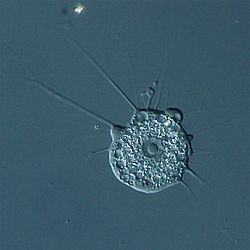| Holomycota Temporal range: Middle Ordovician – Present | |
|---|---|
 | |
| Nuclearia | |
| Scientific classification | |
| Domain: | Eukaryota |
| Clade: | Podiata |
| Clade: | Amorphea |
| Clade: | Obazoa |
| Clade: | Opisthokonta |
| Clade: | Holomycota Liu et al., 2009 |
| Groups [1] | |
| |
| Synonyms | |
| |
Holomycota [3] or Nucletmycea are a basal Opisthokont clade as sister of the Holozoa. It consists of the Cristidiscoidea, also called Nucleariid, as well as the kingdom Fungi. nucleariids are unicellular free-living phagotrophic amoebae, [4] and are considered the earliest lineage of Holomycota. This suggests that animals and fungi independently acquired complex multicellularity from a common unicellular ancestor and that the osmotrophic lifestyle (one of the fungal hallmarks) was originated later in the divergence of this eukaryotic lineage. Opisthosporidians is a recently proposed taxonomic group that includes aphelids, [5] Microsporidia and Cryptomycota, three groups of endoparasites. [6]
Rozella (Cryptomycota) is the earliest diverging fungal genus in which chitin has been observed at least in some stages of their life cycle, [6] although the chitinous cell wall (another fungal hallmark) and osmotrophy originated in a common ancestor of Blastocladiomycota and Chytridiomycota, which still contain some ancestral characteristics such as the flagellum in zoosporic stage. [7] The groups of fungi with the characteristic hyphal growth, Zoopagomycota, Mucoromycotina and Dikarya, originated from a common ancestor ~700 Mya. [7] Zoopagomycota are mostly pathogens of animals or other fungi, Mucoromycotina is a more diverse group including parasites, saprotrophs or ectomycorrhizal. [6] Dikarya is the group embracing Ascomycota and Basidiomycota, which comprise ~98% of the described fungal species. [7] Because of this rich diversity, Dikarya includes highly morphologically distinct groups, from hyphae or unicellular yeasts (such as the model organism Saccharomyces cerevisiae ) to the complex multicellular fungi popularly known as mushrooms. [7] Contrary to animals and land plants with complex multicellularity, the inferred phylogenetic relationships indicate that fungi acquired and lost multicellularity multiple times along Ascomycota and Basidiomycota evolution. [8]

